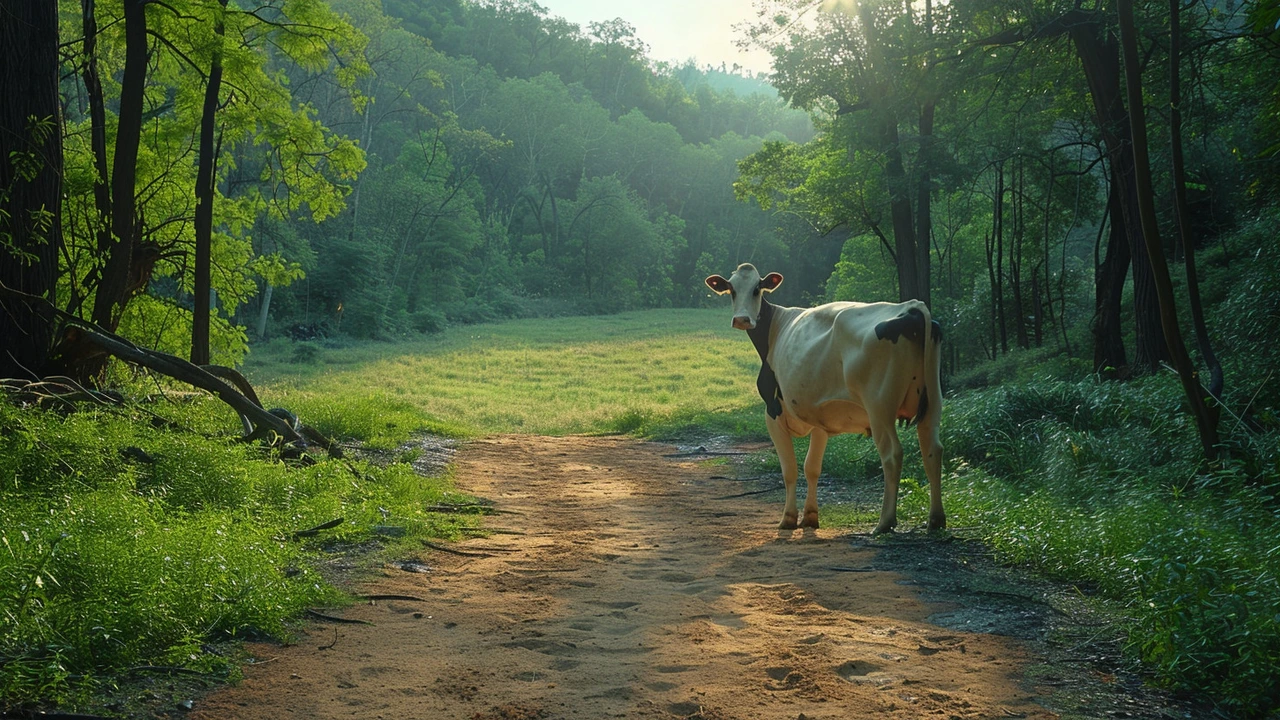New Guidelines Issued by Kenya Forest Service for Grazing in Public Forests
The Kenya Forest Service (KFS) has announced a series of new guidelines designed to regulate grazing practices within the nation's public forests. This move is primarily aimed at ensuring the sustainable management of Kenya's vital forest resources, which are essential not only for biodiversity but also for the myriad of ecosystem services they provide. The announcement, signed by the Chief Conservator, underlines the significance of these changes for the future of Kenya's forests and the communities that rely on them.
Regulated Grazing Areas
Under the new guidelines, there are specific restrictions on where herders can graze their animals. Grazing in newly planted areas, specifically plantations that are less than four years old, is now strictly prohibited. These young plantations are critical as they represent the future of the forest canopy, which is vital for various ecological processes. Furthermore, areas designated for rehabilitation and natural regeneration are also off-limits. Such zones are usually targeted for recovery from previous deforestation or degradation activities, and grazing in these areas could hamper their ability to regenerate naturally.
Importantly, the guidelines also protect ecologically sensitive areas such as natural springs, swamps, and river sources. These areas are crucial for maintaining the hydrological cycle and supporting wildlife. Disturbance from grazing could lead to soil erosion, water contamination, and a loss of biodiversity.
Permits and Compliance Requirements
To enforce these new rules, KFS has introduced a mandatory monthly permit system. Herders must adhere strictly to specific requirements to obtain these permits. One of the primary requirements is the completion of a forest zonation and mapping process, which ensures that only suitable areas are used for grazing. The establishment of a grazing register at each forest station is another critical requirement. This register will help in monitoring the number of grazing animals and the areas they are using, thereby preventing overgrazing which can lead to land degradation.
The guidelines also emphasize the importance of adhering to the carrying capacity of the land. Overgrazing can lead to soil erosion, loss of vegetation cover, and decreased land productivity, which can have severe long-term consequences for both the environment and local communities. As such, the number of animals allowed to graze in a particular area will be strictly determined by the Forest Station Manager based on the land's carrying capacity. Grazing will be allowed only from 6 am to 7 pm, thereby reducing the risk of nocturnal activities that could further stress the ecosystem.
Prohibitions and Penalties
Under the new guidelines, herders are prohibited from constructing cattle enclosures or any makeshift structures within the forest. This measure aims to prevent any permanent or semi-permanent changes to the forest landscape that could impede natural processes and contribute to habitat destruction. Non-compliance with these guidelines could lead to severe penalties. Herders who fail to adhere to the rules may lose their grazing rights, face prosecution, and have their animals confiscated.
The Chief Conservator's signed statement articulates the rationale behind these stringent measures. By enforcing these guidelines, KFS aims to balance the needs of local herders with the imperative to preserve Kenya's forests for future generations. The fees associated with the permits, currently set at Ksh100 per cow per month, and the penalty fee of Ksh500 per cow for releasing detained animals, are designed to incentivize compliance and provide funding for ongoing forest management and conservation efforts.
Implications for Herders and Local Communities
While these new measures represent a significant shift in forest management practices, they are essential for safeguarding Kenya's precious forest resources. Herders and local communities will need to adapt to these changes, balancing their economic activities with the need for environmental stewardship. The maintenance of forest health is crucial not just for the environment, but also for the long-term economic wellbeing of the communities that rely on these forests for livelihoods, water, and other resources.
The implementation of these guidelines will require concerted efforts from all stakeholders, including KFS, herders, and local communities. It will be important for KFS to engage with herders, providing education and support to help them understand and comply with the new regulations. This collaborative approach will be key to the successful implementation of the guidelines and the long-term sustainability of Kenya's forests.
In conclusion, the new guidelines issued by KFS are a crucial step towards ensuring the sustainable management of Kenya's forests. By regulating grazing practices and protecting sensitive areas, KFS aims to preserve these valuable ecosystems for future generations. Herders and local communities will need to adapt to these changes, but with the right support and cooperation, it is possible to achieve a balance between economic needs and environmental conservation. The future of Kenya's forests depends on our collective commitment to sustainable management practices, and these guidelines are a significant step in that direction.







Hemanth NM
June 11, 2024 AT 18:40New grazing rules will definitely affect many herders, hope the permits process stays simple.
rin amr
June 12, 2024 AT 22:27The recent KFS grazing decree reads like a bureaucratic novella, each clause meticulously crafted to curtail pastoral freedom.
One cannot help but admire the administrative acumen that went into mapping every hectare, though the average herder might view it as an onerous labyrinth.
By restricting access to nascent plantations, the agency ostensibly safeguards future canopy, yet it simultaneously sidelines those whose livelihoods hinge on these very plots.
The mandatory monthly permit, priced at a modest Ksh100 per head, elegantly intertwines revenue generation with compliance enforcement.
Such a fee structure, however, presupposes that every herder possesses the fiscal elasticity to absorb recurring expenditures.
Moreover, the stipulated grazing window of 6 am to 7 pm imposes a temporal discipline that may clash with traditional grazing patterns dictated by seasonal water availability.
The prohibition on constructing enclosures, while laudable from an ecological standpoint, disregards the pragmatic need for herd management in open forest corridors.
It is commendable that the guidelines highlight ecologically sensitive zones such as springs and swamps, acknowledging their role in hydrological stability.
Yet, the enforcement mechanism-reliant on a grazing register at each forest station-raises concerns about administrative capacity and potential corruption.
If the register is to become a transparent ledger, stakeholders must be granted unfettered access to audit its entries.
The rhetoric of sustainability permeates the document, but one must interrogate whether the prescribed carrying capacities are grounded in rigorous scientific assessment.
Absent robust ecological data, the prescribed animal quotas risk being arbitrary, fueling resentment among herders.
From a sociocultural perspective, the guidelines appear to prioritize forest health over the intangible heritage of pastoral communities.
A collaborative approach-perhaps involving participatory mapping workshops-could bridge the chasm between conservation objectives and local knowledge.
In sum, while the KFS's intent is undeniably progressive, the implementation blueprint demands nuanced calibration to avoid unintended socioeconomic fallout.
Jai Bhole
June 14, 2024 AT 02:13These new KFS rules feel like a colonial imposition on our age‑old grazin traditions. The govt thinks they can dictate where we take our cattle like some distant overseer. If we don't follow, they'll slap us with fines and even take our animals – that's pure oppression. Our ancestors roamed these lands long before any permit existed, and we ain't gonna surrender that heritage. It's time to stand up and remind them who truly belongs in the forest.
rama cs
June 15, 2024 AT 06:00The regulatory schema presented manifests an ontological tension between anthropogenic land‑use and sylvan ecosystem integrity. By invoking carrying capacity metrics without empirical substantiation, the policy risks epistemic vacuity. The prohibition of enclosures epitomizes a reductive view of pastoral praxis, marginalizing adaptive management frameworks. Stakeholder engagement, albeit rhetorically championed, remains perfunctory in the current draft. Consequently, the envisaged ecological equilibrium may remain aspirational rather than actionable.
Monika Kühn
June 16, 2024 AT 09:47Oh great, now we need a monthly ticket to let our cows take a stroll through the trees. As if the forests were waiting impatiently for a herd selfie. The fee structure is practically a charity for the forest service – who said conservation costs money? Guess we'll just let the cows meditate by the river instead.
Surya Prakash
June 17, 2024 AT 13:33The new permit fees feel excessive for small‑scale herders.
Sandeep KNS
June 18, 2024 AT 17:20It is both admirable and mildly bewildering that the Kenya Forest Service deems a one‑hundred‑shilling per bovine charge a ‘sustainable financing model.’ One must applaud such fiscal ingenuity.
Mayur Sutar
June 19, 2024 AT 21:07I get the admiration for the paperwork, but let’s be real – most herders don’t have a PhD in forestry to fill out those zonation maps. The monthly cost adds up, especially when you’re juggling school fees and clinic visits. Also, the 6 am‑7 pm window may clash with when water sources are most accessible. If the registers are transparent, that could build trust, but only if they’re not just another bureaucratic hurdle. Perhaps community liaisons could help simplify the process and explain the science behind the quotas. In the meantime, many will feel the sting of extra fees without seeing immediate forest benefits. A bit of grassroots involvement could turn this top‑down decree into a collaborative effort.
Nancy Ortiz
June 21, 2024 AT 00:53The terminological flourish of ‘colonial imposition’ certainly adds gravitas, yet the underlying issue remains: operational feasibility. Field operatives often lack the capacity to enforce such granular restrictions, leading to selective compliance. Moreover, the notion of ‘ancestral rights’ must be reconciled with contemporary ecosystem services valuation. Without integrating local ecological knowledge, the policy risks becoming a performative gesture rather than a functional framework. In short, the rhetoric outpaces the logistical reality.
Ashish Saroj( A.S )
June 22, 2024 AT 04:40Interesting points, Mayur; however, the assumption that community liaisons will magically resolve systemic inertia is optimistic-perhaps naïve. The permit fees, while seemingly modest, could create a cumulative barrier that disproportionately impacts marginal herders. Transparency in registers is commendable, yet without independent oversight, they may simply become another layer of red tape. Ultimately, the success of these guidelines hinges on enforceable accountability, not just good intentions.